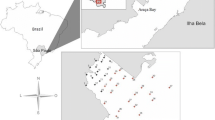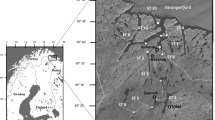Abstract
The response of bacterial isolates from Antarctic sediments to polychlorinated biphenyls (Aroclor 1242 mixture), heavy metal salts (cadmium, copper, mercury and zinc) and antibiotics (ampicillin, chloramphenicol, kanamycin and streptomycin) was investigated. Overall, the ability to growth in the presence of Aroclor 1242 as a sole carbon source was observed for 22 isolates that mainly belonged to Psychrobacter spp. Tolerance to the heavy metals assayed in this study was in the order of Cd > Cu > Zn > Hg and appeared to be strictly related to the metal concentrations, as determined during previous chemical surveys in the same area. With regards to antibiotic assays, the response of the isolates to the tested antibiotics ranged from complete resistance to total susceptibility. In particular, resistances to ampicillin and chloramphenicol were very pronounced in the majority of isolates. Our isolates differently responded to the presence of toxic compounds primarily based on their phylogenetic affiliation and secondarily at strain level. Moreover, the high incidence of resistance either to metal or antibiotics, in addition to the capability to grow on PCBs, confirm that bacteria are able to cope and/or adapt to the occurrence pollutants even in low human-impacted environments.



Similar content being viewed by others
References
Andrade S, Poblet A, Scagliola M, Vodopivez C, Curtosi A, Pucci A, Marcovecchio J (2001) Distribution of heavy metals in surface sediments from an Antarctic marine ecosystem. Environ Monit Assess 66:147–158
Bargagli R, Nelli L, Ancora S, Focardi S (1996) Elevated cadmium accumulation in marine organisms from Terra Nova Bay (Antarctica). Polar Biol 16:13–520
Bargagli R, Monaci F, Sanchez-Hernandez JC, Cateni D (1998) Biomagnification of mercury in an Antarctic marine coastal food web. Mar Ecol Progr Ser 169:65–76
Bedard DL, Wagner RE, Brennan MJ, Haberl ML, Brown JF Jr (1987) Extensive degradation of Aroclors and environmental transformed polychlorinated biphenyls by Alcaligenes eutrophus H850. Appl Environ Microbiol 53:1094–1102
Caroppo C, Stabili L, Aresta M, Corinaldesi C, Danovaro R (2006) Impact of heavy metals and PCBs on marine picoplankton. Environ Toxicol 21:541–551
Chandy JP (1999) Heavy metal tolerance in chromogenic and non-chromogenic marine bacteria from Arabian Gulf. Environ Monit Assess 59:321–330
Dalla Riva S, Abelmoschi ML, Magi E, Soggia F (2004) The utilization of the Antarctic environmental specimen bank (BCAA) in monitoring Cd and Hg in an Antarctic coastal area in Terra Nova Bay (Ross Sea - Northern Victoria Land). Chemosphere 56:59–69
De Domenico M, Lo Giudice A, Michaud L, Saitta M, Bruni V (2004) Diesel oil and PCB-degrading bacteria isolated from Antarctic seawater (Terra Nova Bay, Ross Sea). Polar Res 23:141–146
De Souza M-J, Nair S, Loka Bharathi PA, Chandramohan D (2006) Metal and antibiotic-resistance in psychrotrophic bacterial from Antarctic marine waters. Ecotoxicology 15:379–384
Dercová K, Seligová J, Dudásová H, Mikulášová M, Šilhárová K, Tóthová L, Hucko P (2009) Characterization of the bottom sediments contaminated with polychlorinated biphenyls: evaluation of ecotoxicity and biodegradability. Intl Biodet Biodegr 63:440–449
Fuoco R, Colombini MP, Abete C (1994) Determination of polychlorobiphenyls in environmental samples from Antarctica. Int J Environ Anal Chem 55:15–25
Fuoco R, Colombini MP, Abete C, Carignani S (1995) Polychlorobiphenyls in sediment, soil and sea water samples from Antarctica. Int J Environ Anal Chem 61:309–318
Gillan DC, Danis B, Pernet P, Joly G, Dubois P (2005) Structure of sediment-associated microbial communities along a heavy-metal contamination gradient in the marine environment. Appl Environ Microbiol 71:679–690
Giordano R, Lombardi G, Ciaralli L, Beccaloni E, Sepe A, Ciprotti M, Costantini S (1999) Major and trace elements in sediments from Terra Nova Bay, Antarctica. Sci Total Environ 227:29–40
Grotti M, Soggia F, Lagomarsino C, Dalla Riva S, Goessler W, Francesconi KA (2008) Natural variability and distribution of trace elements in marine organisms from Antarctic coastal environments. Antarc Sci 20:39–51
Haferburg G, Kothe E (2007) Microbes and metals: interactions in the environment. J Basic Microbiol 47:453–467
Ianni C, Magi E, Soggia F, Rivaro P, Frache R (2010) Trace metal speciation in coastal and off-shore sediments from Ross Sea (Antarctica). Microchem J 96:203–212
Kohler HPE, Kohler-Staub D, Focht DD (1988) Cometabolism of polychlorinated biphenyls: enhanced transformation of Aroclor 1254 by growing bacterial cells. Appl Environ Microbiol 54:1940–1945
Kumar S, Tamura K, Nei M (1993) Mega: molecular evolutionary genetics analysis, version 1.02. The Pennsylvania State University, University Park, Pa 16802
Lo Giudice A, Casella P, Caruso C, Mangano S, Bruni V, De Domenico M, Michaud L (2010) Occurrence and characterization of psychrotolerant hydrocarbon–oxidizing bacteria from surface seawater along the Victoria Land coast (Antarctica). Polar Biol 33:929–943
Lo Giudice A, Caruso C, Mangano S, Bruni V, De Domenico M, Michaud L (2012) Marine bacterioplankton diversity and community composition in an Antarctic coastal environment. Microb Ecol 63:210–223
Martinez JL (2009) Environmental pollution by antibiotics and by antibiotic resistance determinants. Environ Poll 157:2893–2902
Michaud L, Di Cello F, Brilli M, Fani R, Lo Giudice A, Bruni V (2004) Biodiversity of cultivable Antarctic psychrotrophic marine bacteria isolated from Terra Nova Bay (Ross Sea). FEMS Microbiol Lett 230:63–71
Michaud L, Di Marco G, Bruni V, Lo Giudice A (2007) Biodegradative potential and characterization of psychrotolerant polychlorinated biphenyl-degrading marine bacteria isolated from a coastal station in the Terra Nova Bay (Ross Sea, Antarctica). Mar Poll Bull 54:1754–1761
Montone RC, Taniguchi S, Weber RR (2001) Polychlorinated biphenyls in marine sediments of Admiralty Bay, King George Island, Antarctica. Mar Pollut Bull 42:611–614
Montone RC, Taniguchi S, Boian C, Weber RR (2005) PCBs and chlorinated pesticides (DDTs, HCHs and HCB) in the atmosphere of the southwest Atlantic and Antarctic oceans. Mar Poll Bull 50:778–786
Saitou N, Nei M (1987) The neighbor-joining method: a new method for reconstructing phylogenetic trees. Mol Biol Evol 4:406–425
Selvin J, Shanmugha PS, Kiran GS, Thangavelua T, Bai NS (2009) Sponge-associated marine bacteria as indicators of heavy metal pollution. Microbiol Res 164:352–363
Thompson JD, Higgins DG, Gibson TJ (1994) CLUSTAL W: improving the sensitivity of progressive multiple sequence alignment through sequence weighting, position-specific gap penalties and weight matrix choice. Nucl Acids Res 22:4673–4680
Tumeo MA, Guinn DA (1997) Evaluation of bioremediation in cold regions. J Cold Reg Engin 11:221–231
Vaz-Moreira I, Nunes OC, Manaia CM (2011) Diversity and antibiotic resistance patterns of Sphingomonadaceae isolates from drinking water. Appl Environ Microbiol 77:5697–5706
Yakimov MM, Giuliano L, Bruni V, Scarfì S, Golyshin PN (1999) Characterization of Antarctic hydrocarbon-degrading bacteria capable of producing bioemulsifiers. New Microbiol 22:249–259
Acknowledgments
This research was supported by grants from PNRA (Programma Nazionale di Ricerche in Antartide), Italian Ministry of Education and Research (Research Project PNRA 2004/1.6), and from MNA (Museo Nazionale dell’Antartide).
Author information
Authors and Affiliations
Corresponding author
Rights and permissions
About this article
Cite this article
Lo Giudice, A., Casella, P., Bruni, V. et al. Response of bacterial isolates from Antarctic shallow sediments towards heavy metals, antibiotics and polychlorinated biphenyls. Ecotoxicology 22, 240–250 (2013). https://doi.org/10.1007/s10646-012-1020-2
Accepted:
Published:
Issue Date:
DOI: https://doi.org/10.1007/s10646-012-1020-2




